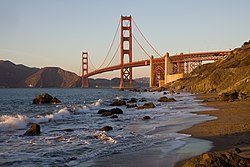Transport
Transport, or transportation, is moving people or things from one place to another place.[1] Transport can be divided into infrastructure, vehicles and operations.
Infrastructure includes cableways, roads, railways, airports, canals and pipelines. The infrastructure is the network where things are carried. Infrastructure also includes airports, railway stations, bus stations and seaports (docks). Infrastructure is usually built by governments and paid for by taxes from the citizens of a country or region. Infrastructure such as roads and railways are designed by civil engineers and urban planners.
Vehicles or vessels travel on the infrastructure. Vehicles include cable cars, cars, trucks, trains, spaceships and airplanes. Vehicles are usually designed by mechanical engineers. Vessels include boats, ferries, and barges which travel on canals and use docks and seaports. In the same way that trains use train stations, airplanes use airports. In the same way that trains use railway lines (train tracks), airplanes use flight paths and then fly in the sky.[2]
Operations control the system. Operations include traffic signals, railway signals and air traffic control. Operations also include the government policies (a policy is a plan of action to guide decisions and actions) and regulations (a set or group of laws and rules) used to control the system, such as tolls, fuel taxes, and traffic laws.
Transport and communications
Transport and communication can be used instead of each other (someone could telephone a person rather than visit them). Transport traffic also needs communication. For example, air traffic control lets more airplanes fly. So, an increase of either transport or communication usually leads to an increase in the other one.
Transport, energy, and the environment
Transport uses a lot of energy. Trams, trolleybuses and trains use electricity and cycling is human-powered. Most transport uses hydrocarbons (oil and gas). This can create pollution. Environmental regulations (laws) and low-pollution fuels (for example liquified natural gas) can reduce pollution. But as more vehicles are used, more pollution is created. Ethanol and biodiesel pollute less than petroleum.
Kinds of transportation
Transport can be by cable, land, water or air:
- Cable using cableways. e.g. cable cars and ski lifts etc.
- Land transport using walking, roads and railway tracks.[3] by bicycles and other vehicles. e.g. buses, cars, trucks, trains, trams, bikes etc.
- Water transport using ships and barges in canals, and in rivers and seas.[4] e.g. ships, submarines, jet skis etc.
- Air transport using airplanes and airports and helicopters.[5] e.g. jets, aeroplanes etc.
- Pipeline
Transport Media
Various modes of transport in Manchester, England
Human-powered transport remains common in developing countries.
An Air France Airbus A318 landing at London Heathrow Airport
Intercity Express, a German high-speed passenger train
Automobile ferry in Croatia
Bridges, such as Golden Gate Bridge, allow roads and railways to cross bodies of water.
Tunnels, such as the Tampere Tunnel, allow traffic to pass underground or through rock formations.
References
- ↑ Transport in Japan, "What is transport?"; retrieved 2012-9-5.
- ↑ Transport in Japan, "There are paths even in the air"; retrieved 2012-9-5.
- ↑ Transport in Japan, "Land vehicles"; retrieved 2012-9-5.
- ↑ Transport in Japan, "Sea vehicles"; retrieved 2012-9-5.
- ↑ Transport in Japan, "Air vehicles"; retrieved 2012-9-5.
Other websites
![]() Media related to Transport at Wikimedia Commons
Media related to Transport at Wikimedia Commons











